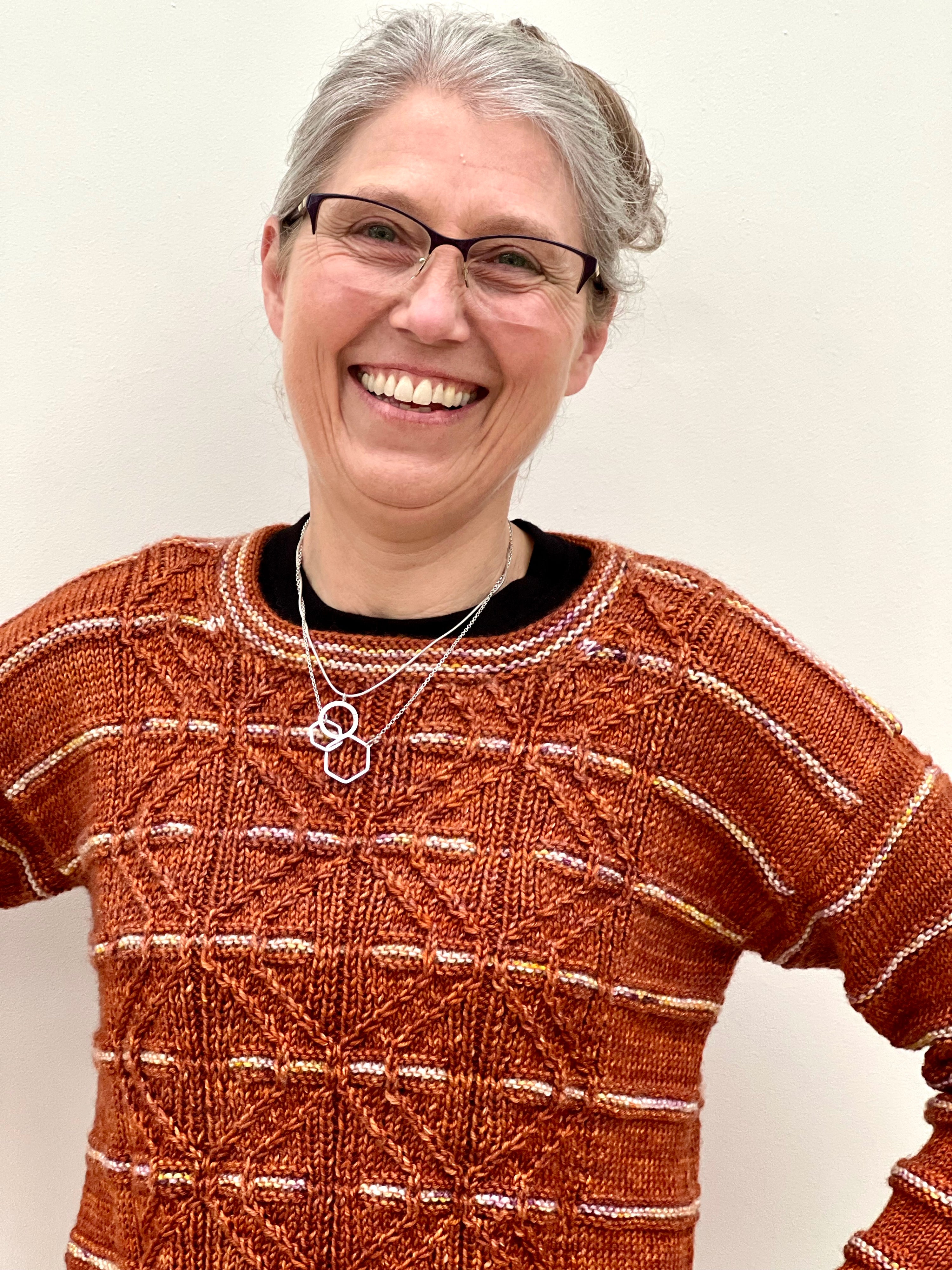
Interview with designer Emma Vining

I'm delighted to have been able to interview Emma Vining, the designer behind the lovely Leadenhall Sweater, which she designed using Oh So Fine! DK. The design was published in The Knitter Magazine issue 188 last year, and you can now buy it directly from Emma. 20% off The Leadenhall Sweater Pattern full price until 3rd November 2024 in Emma’s Ravelry and Payhip stores (discount already applied; no code needed). If you would like a kit, they're available here!
You can find Emma on Instagram and X using the handle @purlemma.
Hi Emma, it’s lovely to be able to feature you on the blog! It’s been a delight to have worked with you on some of the patterns you’ve submitted to The Knitter magazine. Tell me bit about how you got into knitting, and then designing patterns.
Hello Rachael, it’s great to be here on your blog - thank you for inviting me! It is a real pleasure to work with you on my designs for the Knitter Magazine.
In answer to your question, I have always loved learning new knitting techniques, and after participating in many different classes, I decided to enrol in a City and Guilds course all about design. It was during this excellent course that I first learned how to design and write patterns that other knitters could also enjoy. After completing my City and Guilds course, I began submitting design ideas to magazines. This resulted in my first published pattern in The Knitter Magazine, a tea cosy in Issue 40, followed by several accessory designs in subsequent issues. My first published garment was my Sugar Kelp Sweater in The Knitter Issue 55. The cable pattern was inspired by a beautiful frond of seaweed that I found on the beach near Sidmouth in Devon.
I’m delighted to say that I recently reached, and passed, a major milestone of 150 published knitting patterns! As well as including garment and accessory patterns for magazines, I also write and self-publish patterns through Ravelry and Payhip. For many of my designs I have the pleasure of working in close collaboration with independent yarn producers and creative hand dyers like yourself.
It's such a pleasure for me too, to see my yarns being made into such gorgeous knits! I know that you very often take inspiration from the world around you, and I love how you incorporate elements of the urban landscape into your designs. What else inspires you?
As well as the urban environment, I love taking inspiration from the natural world. Two of my recent designs for The Knitter Magazine featured flowers as my starting point. My Lisse sweater in Issue 206 has pattern panels with delicate tulip motifs knitted with twisted stitches. My Waterlily sweater in Issue 207 also uses twisted stitches to create a lily motif with opening leaves and a centre flower bud. For both sweaters, I have placed these motifs on textured backgrounds. I love the contrast between the delicate twisted stitch patterns and the textured knitted surface surrounding them.
I’d love to hear about your design process. Where do you start?
My starting point for a design is often a photo or a sketch. For the Leadenhall sweater I began with one of my favourite sources, architectural structures, and in particular, staircases! I have a large collection of staircase photographs from many different buildings and locations. The zigzagging stitch pattern of the Leadenhall sweater is based on a staircase which changes in direction at each building level. The resulting twisted stitch pattern is knitted as a mirror-imaged panel on the front and back of the sweater.
Can you tell me how Leadenhall came into being, and what made you use that particular yarn?
I am always delighted to find special yarns for my designs and your beautiful Oh So Fine DK yarn was the perfect match for my Leadenhall design. I love the interplay between the two shades, with Sleeping Dragon providing delicate accents of subtle changing shades alongside the deep, rich colour of Spice Market as the main shade. The stitch definition of your lovely yarn is perfect for showing the detail of my twisted stitch and texture patterns. The sheen of silk adds yet another design dimension and the overall effect is a very stylish sweater. Thank you for creating these beautiful shades with this gorgeous yarn!
Totally my pleasure! You’ve written two books, both of which are fantastic resources for adventurous knitters and would-be designers. How were your experiences of putting together your knowledge and experience into book form?
My books reflect my personal design style of working from inspirational design sources. Each book is full of suggestions for knitting inspiration and my aim is to enable readers to create their own personalised designs. This inspiration ranges from ideas for new techniques, sources for designs and suggestions of new ways to create pattern. My first book, A Knitter’s Sketchbook, explored these ideas through cable knitting and my second book, A Knitter’s Guide to Shawl Design, places this idea of working from inspirational sources in the context of shawls.
Writing both books gave me an excellent opportunity to develop new skills, including learning to write and chart a wide variety of different stitch patterns using the excellent Stitchmastery software.
I love Stitchmastery. It's a godsend! If there’s one thing you wish someone had told you about knitting or designing, what would it be?
Experimenting with your knitting is always worthwhile! Through my books and talks, I encourage knitters and crafters to explore and experiment with their knitting, combining their own personal design inspirations with interesting techniques. Sometimes translating ideas into knitting takes several attempts. However, each version can result in new design possibilities which ultimately lead to beautiful knitting patterns that will be cherished and loved.

